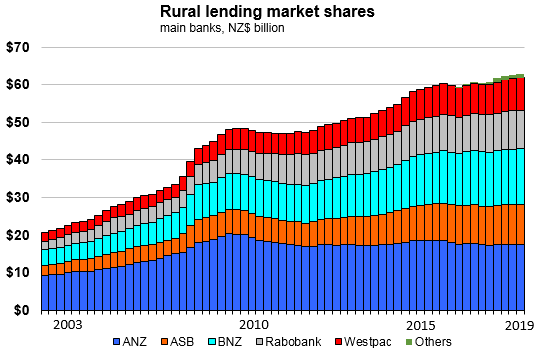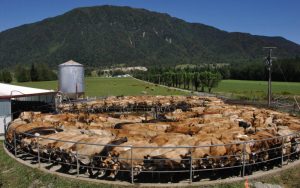
ANZ’s former chief economist, Cameron Bagrie, is wary of the Reserve Bank’s (RBNZ) bank capital proposals turning it into a punching bag.
He maintains the RBNZ is copping too much flak for the dairy farming industry’s woes – many of which have nothing to do with the RBNZ consulting on requiring banks to hold more capital.
Bagrie accepts that if implemented, the RBNZ’s proposals will come at a cost. Yet he’s concerned some of the lobbying against the proposals have conflated what could happen with what’s already happening.
Federated Farmers’ economics and commerce spokesperson Andrew Hoggard last month, for example, told interrst.co.nz: “It is certainly concerning that banks seem to be acting prematurely on what are proposals for consultation.”
Dairy dilemmas external to potential bank capital changes
Bagrie, who now runs a consultancy called Bagrie Economics, stressed to interest.co.nz the fact that banks are already restricting their lending. The dairy sector’s been particularly vulnerable to their changes of appetite because it’s highly leveraged.
Indeed, the RBNZ in its latest Financial Stability Report said that 35% of dairy sector debt was to “highly indebted farms”, defined as farms with more than $35 of debt per kilogram of milk solids produced annually.
Bagrie was concerned the sector is trying to pay down $41 billion of debt at the same time Fonterra’s deleveraging. He said the sector’s net equity position is falling, with dairy land prices on the decline.
Fonterra, in a statement made to the NZX last week on its soft share price, warned: “While the share price does not impact the Co-op’s balance sheet or our ability to operate and pay our bills, it does impact our farmers’ balance sheets.”
If farmers have weaker balance sheets, the value of what dairy loans are secured against falls.
“I do not like some of the signals that I’m seeing at the moment in regard to Fonterra’s share price,” Bagrie said, also noting Fonterra is losing market share.
He said about a third of dairy farmers weren’t making money even with the pay-out being in excess of $6 per kilogram of milk solids.
He didn’t believe milk production would increase over the next decade. What’s more, he said uncertainty over government policy and environmental standards was translating into uncertainty over costs.
“There’s a whole array of complicating issues across the sector… It’s a bit of a perfect storm.”
Bagrie said the sector was being “repriced”, having been “mispriced for risk for a long time”.
“And now I think a few chickens are coming home to roost.”
What adding bank capital changes to the landscape could do
Asked how much more aggressive be believed this “repricing” would be if the RBNZ implemented its bank capital proposals, Bagrie said it was difficult to say at this stage.
“Is there going to be a cost for holding more capital? Yes. Some interest rates will be higher than would otherwise be the case.
“Can we come up with some hard and fast numbers? No. We’re in proposal stage.
“It concerns me how some of the conversations are starting to be shaped…
“There just seems to be this attitude across the financial services sector that borrowers are going to wear all the costs. If borrowers wear all the costs, that tells me there is something fundamentally wrong with the competitive landscape across the banking sector in New Zealand.”
Bagrie said the return on equities of banks operating in New Zealand were “right up there” by international standards and could come down a bit.
“The banks are still going to make a pretty hefty return on their equity. We want banks to be profitable, but I do not agree with getting out there and just saying this is going to be the impact and there are going to be big numbers.”
Bagrie, went further on TVNZ’s Q + A programme to say that he believed banks were “scaremongering”.
‘Next asset price correction could be a belter’
Bagrie said a bit of “tinkering” was required to the RBNZ’s proposal to require banks to hold an additional $20 billion over a minimum of five years.
Yet he said the RBNZ was “in the right area in the spirit of what it’s trying to do” and it still had to be a “big number”.
Bagrie stressed how the 2008 Global Financial Crisis, which happened at a time the RBNZ had more monetary policy ammunition than it does now, showed how vulnerable New Zealand’s banking system was.
“The GFC exposed a fundamental weakness of the NZ economy which is insufficient savings to fund our investment/borrowing needs,” he said.
“Banks remained profitable but a lack of access to foreign capital as credit markets froze made life very difficult for the banking system.
“Aggressive interest rate cuts helped stabilise the NZ and global economy which stopped asset prices falling too far and threatening the banking sector.
“Banks are still very reliant on foreign capital markets to fund a domestic savings shortfall and this remains a point of vulnerability for the banking system in NZ.
“A key issue now is what happens if we experience another GFC? Global interest rates are already incredibly low and fiscal firepower across the G7 is low. China has heavy corporate debt levels.
“The next asset price correction could be a belter.”


























